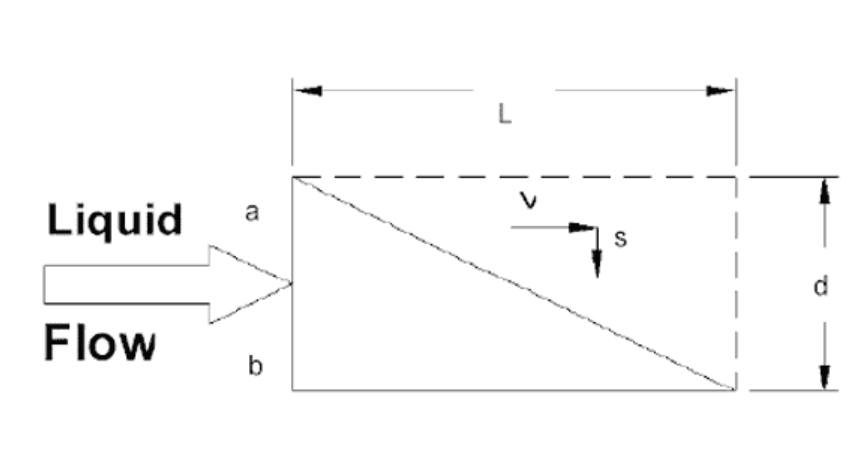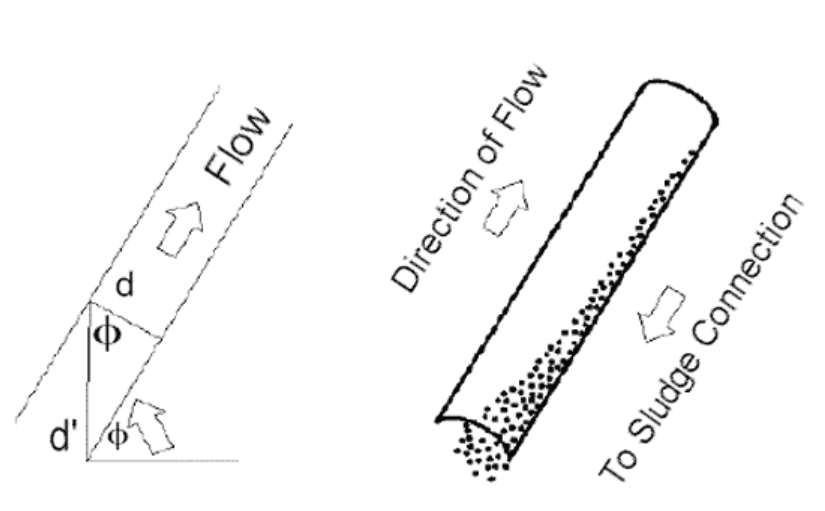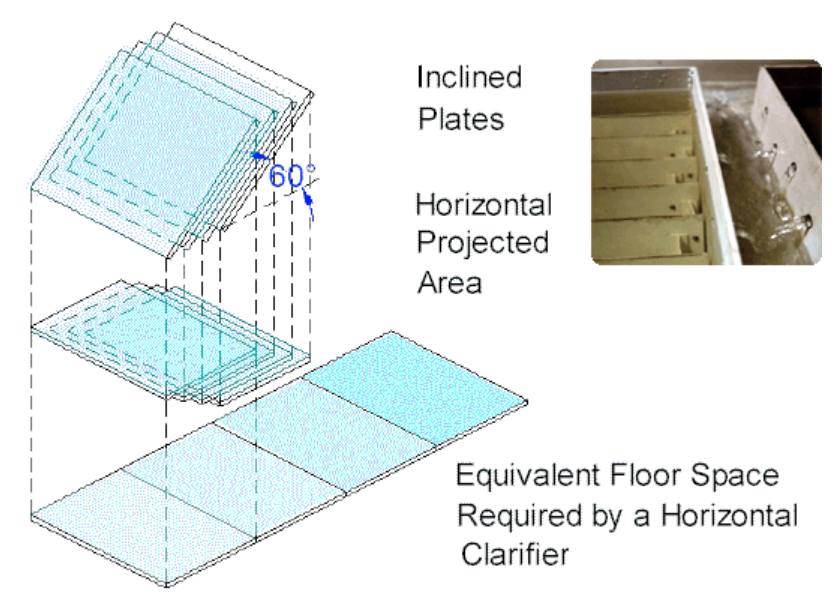Feiyiya Inclined Plate Clarifiers Use Gravity & Innovative Engineering
A gravity clarifier is the most economical method of removing solids from liquids, using natural gravity as the source of energy and it is free. A clarifier simply provides a non-turbulent zone where heavier than liquid solids, suspended by turbulence, are given sufficient time to settle to a quiescent surface. The HEI inclined plate clarifiers are compact units with multiple layers of settling area utilizing less than 25% of the floor space required by conventional clarifiers.
Principle of Clarifiers
A particle carried forward by the velocity of the liquid flow must settle at a rate that allows it to reach the bottom before passing through the clarifer. Thus, particles beginning at a point [a" must traverse some route lying between ab and ab` in order to avoid being carried over the outlet.
If V is the horizontal velocity of the liquid, S the solids particle vertical settling velocity, L the length of the settling device, and D its depth, then particles entering at point A will settle to the bottom of the device only if V does not exceed: S(L/D)Since Vmax / S = L / D then, Vmax = S (L / D)
Inclined plate clarifier, Lanmei inclined plate clarifier, Inclined Tube Settler,High-Efficiency Inclined Tube Wuxi Feiyiya Environmental Protection Technology Co., Ltd. , https://www.feiyya.com
Technical Specifications
Â
Some Other Details
Mechanical Arm
 6×3 m
Â
Technology
From Germany
Workbench
 2.4×0.9 m
Â
Mixing Head
From Germany
Material Bench
 1.2×0.85 m
Â
Operation
From Taiwan Syntec, CNC system
Working Stroke
 2.4×1.2×0.25 m
Â
Hand Controller
From Taiwan Syntec
Gluing Width
 5-30 mm
Â
Motor
Panasonic Servo Motor
Gluing Precision
 0.01 mm
Â
Metering Pump
From Germany, Barmag
Working Speed
 0-12 m/min
Â
Cleaning
Water Rinsing
Max Speed
 30 m/min
Â
Material Barrels
Double-walled stainless steel, temperature-controlled automatically
Repeat Positioning Accuracy
 ± 0.03 mm
Â
Control Mode
8-axis linkage, 1X+1Y+1Z+1mixing+2metering+2reserving
Dosing
 0.5-5 g/s
Â
Working Mode
2D or 3D
Filling Accuracy
 0.1 g/s
Â
Main Color
Silver gray, refer to picture, or black, red, etc., under discussion
Mixing Speed
 0-3000 rad/min
Â
Custom-made, OEM, ODM
OK, no problem
Mixing Ratio
 1:10~10:1 Adjustable
Â
Certifications
CE, RoHS, ISO, etc.
Â
Our Company, MOTECH
Some other companies
Mixing Head
German technology, manufactured in Germany (Germany quality, manufacturing and processing technology), low failure rate
Research, develop and produce in China, Chinese quality.
Working Mode
2D or 3D (can process special 3D patterns, no need for additional equipment)
2D
Control Mode
8-axis linkage (controlled as a whole, more stable and precise, and can adjust and change to 3-components according to practical situations)
Several controlling systems working together, all must be matching
Gluing Width (Standard type)
5-30mm
8-30mm
Gluing Width (Micro-type)
2-8mm
3-8mm
Repeat Positioning Accuracy
±0.03mm
±0.05mm
Dosing
0.5~5g/s
1~4g/s
Offer
Very competitive
Higher

Therefore, the velocity at which a horizontal clarifying device may be operated successfully is directly proportional to its length and inversely proportional to its depth.
This analysis applies to multiple horizontal plate units also. The spacing between plates is usually a few inches as opposed to a depth of several feet in a horizontal tank; therefore, [settling-out" times are dramatically reduced. The flow must be non-turbulent to prevent settled solids from being re-entrained within the moving liquid. Small plate spacing and a large surface area permits laminar flow at higher velocities than large horizontal tanks would allow.
Horizontal clarifying devices become self-flushing if they are inclined at an angle which exceeds the angle of repose of the settled solids. In such cases, flow enters the lower end of the device where settling particles move to the floor eventually sliding back out the entrance. Clear effluent leaves the top of the device.
 However, when the device is inclined, the furthest settling particles no longer fall through distance D but some longer distance D`. This new longer settling distance D` is related to D by the relation: D = D` cos Ø.
However, when the device is inclined, the furthest settling particles no longer fall through distance D but some longer distance D`. This new longer settling distance D` is related to D by the relation: D = D` cos Ø.
Theta [Ø" is the angle, the device is inclined to the horizontal plane. Thus settling distance is increased by the factor: 1/cos Ø In the case where Ø = 60º, 1/cos Ø = 2.
The maximum settling distance is twice the distance between the plates. It is apparent then that the lower the angle of inclination, the smaller the settling distance. However, the angle of inclination must exceed the angle of repose of the solids to be separated. The previous equation may be modified to express the cosine of an inclined plate clarifying system as:
Vmax = L / (D / cosØ) (s) = L·cosØ / D (s)
Inclined Plate Clarifiers
A reduction of the required floor space is acquired by diminishing the separation between the horizontal plates to a few inches and stacking the settling surfaces. Inclining the plates to provide self flushing, 45º for heavy particles and 60º for light particles, reduces the available horizontal projected area (effective settling area) by a factor equivalent to the cosine of the angle. The surface area diagram (below) graphically compares the floor space requirements of an HEI inclined plate clarifier with the equivalent horizontal projected settling area.
Settling Rate
The settling rate for a specific solids should be determined by standard laboratory tests. Light particles, such as metal hydroxides, usually require a design parameter of 0.25 – 0.50 gallons per minute per square foot of horizontal projected area. These low density solids require the inclined plates to be set at a 60º angle to induce the particles to slide down the plate. Heavier particles (such as sand that easily flow) will readily slide from plates set at a 45º angle.

Maximum flow rate of an inclined plate clarifier is based on the flow rate per unit of a horizontally projected surface area. Retention time in the clarifier is not a design criteria. However, attaining optimum performance requires the prudent design to recognize several additional, very important factors.
Polyurethane Foam Gasket Machine (MD-303)
**Product Specifications**
**Main Parts**
1. **Mixing Head**: Water rinsing and modular design. A 2- or 3-component mixing head with a high-pressure water rinsing system and dynamic mixing system, suitable for liquid to high-viscous polymer reaction materials for gasketing, gluing, and potting.
2. **Operation System**: CNC system from SYNTEC, 180-degree rotation, multi-language selection, storage of frequently-used information, USB interface, G-code program, and manual operation option.
3. **Raw Material Barrels**: Double-walled stainless steel, temperature controlled automatically.
4. **Workbench**: Aluminum alloy, strong and durable.
5. **Dosing System**: Barmag metering pump, Panasonic servo motor, capable of micro-scale gluing.
6. **Hand Controller**: Made by SYNTEC, easy to operate, quick and stable response.
7. **Driving System**: Panasonic servo motor, steady operation, long lifespan, can run for dozens of hours.
**Our Equipment Advantage**
**Some Certifications, Patents, Honors We Have**
**Applications**
MOTECH FIPFG Sealing Equipment is widely used in fields such as cabinets, vehicles, electronics, appliances, lighting, and filters.
- **Electronics & Appliances**: Gluing and sealing on controller cabinets, doors, or other surfaces to prevent dust and moisture.
- **Lighting**: Foam sealing to create sealing rings for industrial, furniture, home, or outdoor lighting.
- **Small Containers & Packing Cases**: Sealing rings applied to cover edges efficiently and automatically.
- **Appliances**: Sealing strips needed for kitchenware tops, backs, interiors, or filters of cleaners and other appliances.
- **Vehicles**: Sealing strips used on car bodies, pedals, steering wheel stands, fireproof metal plates, windows, vents, lighting covers, air conditioners, etc.
- **Filters**: Used in oil industry, air conditioners, buildings, refrigerators, etc.
**Some Other Accessory Settings**
**About MOTECH**
MOTECH is a professional supplier and manufacturer of polyurethane automatic equipment systems and other sealing systems, integrating design, R&D, production, marketing, and after-sales services. Based in Dalian, one of the most important port cities in northern China.
We have an excellent R&D team consisting of professionals in chemical engineering, machinery, and automation. Our machining capabilities are versatile and powerful, with a specialized factory for custom-made equipment. The core technology of our products is top-level, sourced from Germany, and components come from world-renowned suppliers. Our service system is comprehensive, featuring a vast distribution network, professional technical support, and an excellent after-sales service team.
**Main Products**
- 2/3-components FIPFG sealing solutions equipment
- PU Foam Sealing Equipment
- Microscale Sealing System
- Cabinet Sealing Machine
- Lighting Sealing Gasket Machine
- Automatic Car Sealing System
- Silicone Sealing Equipment
- Dispensing Machine
- Spreading Equipment
- Gluing Machine
- Thermally Insulating Aluminum Profiles Gluing & Cutting Equipment
- Custom-Made Machinery
**We Believe**
Innovation leads the future, and cooperation creates a better future.
**Our Customers' Locations**
EU, US, Middle East, Qatar, India, Philippines, UK, Iran, Korea, Taiwan, Russia, China, etc.
**Main Clients**
Volvo, Toyota, Far East Power, CLP Power Hong Kong, and more.
Model NO.: MD-303
Mechanical Arm: 6*3 M
Workbench: 2.4*0.9 M
Material Bench: 1.2*0.85 M
Working Stroke: 2.4*1.2*0.25 M
Gluing Width: 5-30 mm
Gluing Precision: 0.01 mm
Working Speed: 0-12 M/Min
Trademark: MOTECH
Transport Package: Plywood Case Packaged
Specification: CE; ROHS
Origin: Shanghai, China
HS Code: 8479899990
**New Technology Machine Manufacturer**
A 2-component FIPFG automatic PU foam gasket sealing equipment that mixes two types of raw materials and applies them directly to pre-set positions, grooves, molds, or flat surfaces of workpieces. Through a chemical reaction, the liquid raw materials form an elastic sealing strip in seconds. This method eliminates joints or cut points, offering superior performance compared to traditional sealing methods with longer service life. During the forming process, the surface of the sealing strip becomes smooth without cracks, ensuring excellent sealing results. The machine adheres naturally and tightly to the workpiece, eliminating the need for manual gluing, thus saving labor and time costs.
This foam sealing equipment is widely used in industries such as control cabinets, lighting, automotive, and machining. It provides leak-proof, oil-proof, water-proof, damping, noise reduction, and sealing properties. It complies with certifications like UL/CE, MIL-STD-167, EN50298, and more.
**Equipment Construction**
**Raw Material Reaction Principle**
**Standard Type Equipment Specifications**
